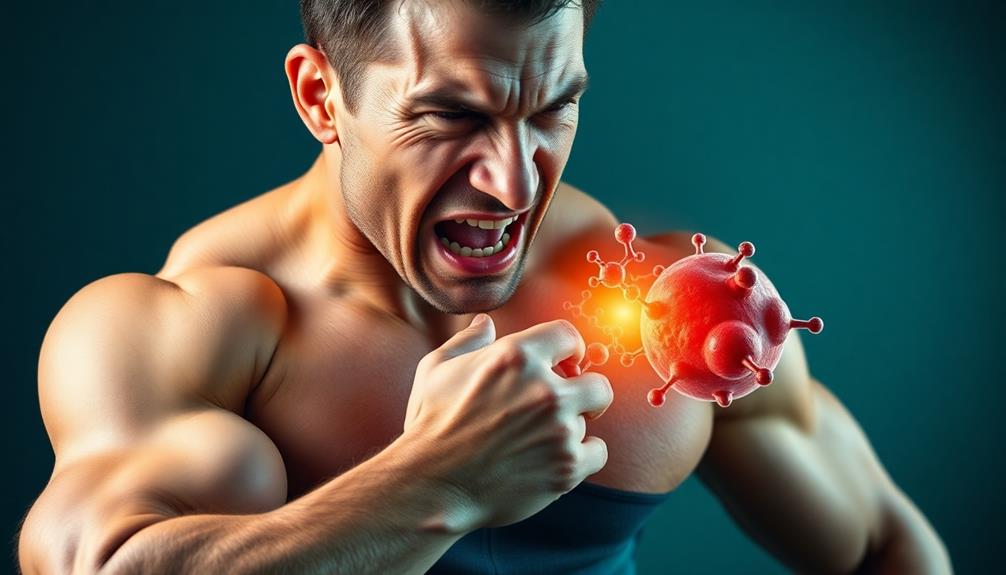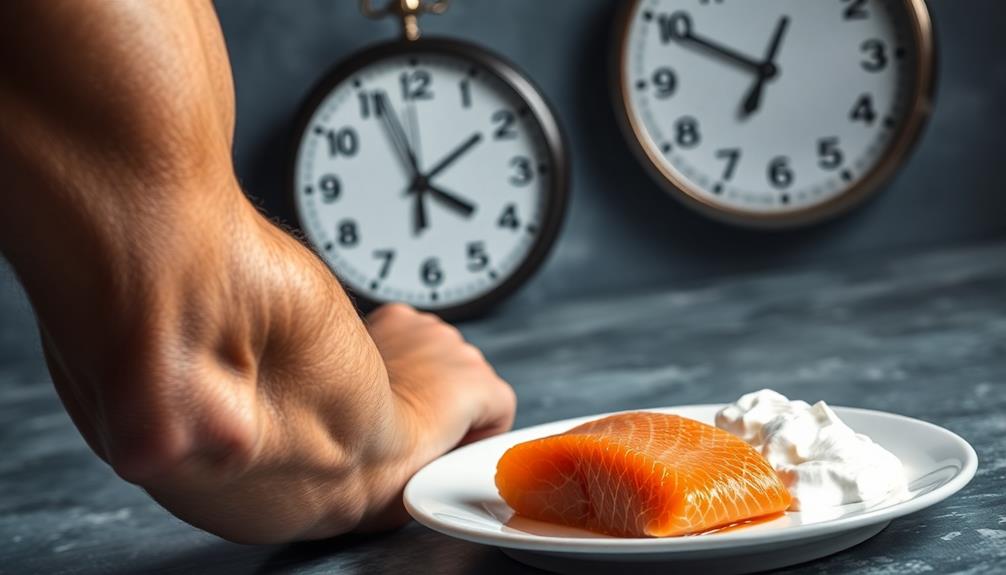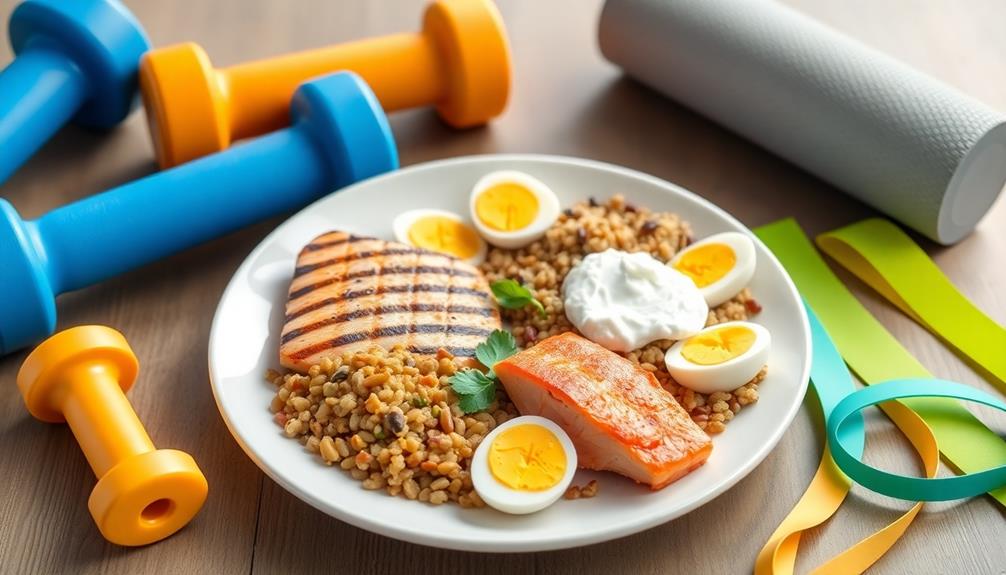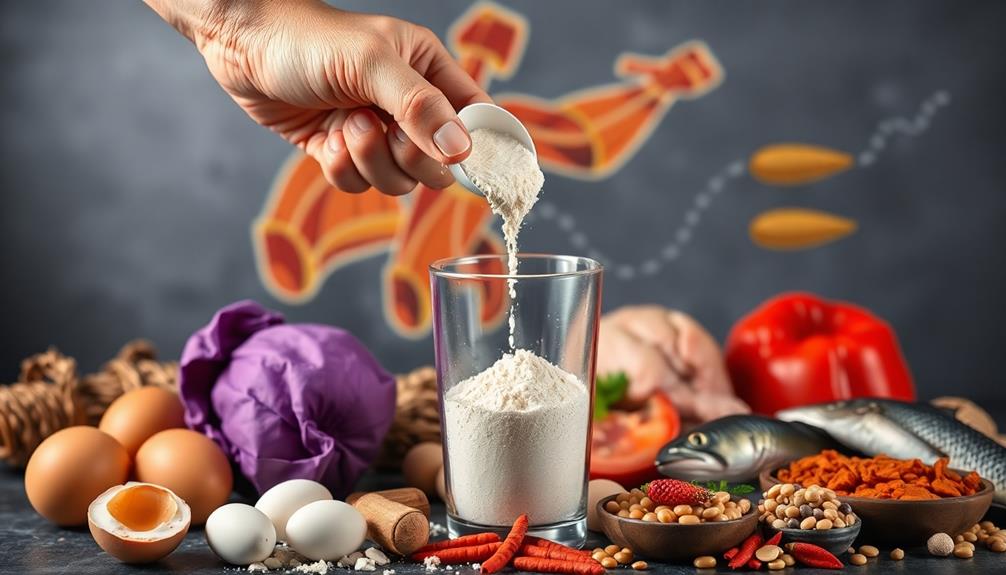To manage DOMS through ideal protein intake, focus on consuming high-quality protein sources before and after your workouts. Aim to eat protein-rich foods like lean meats, fish, eggs, or plant-based options 2-3 hours before exercising, and within 30 minutes to an hour post-workout. This timing helps reduce muscle damage and supports repair. Spread your protein intake throughout the day to aid recovery and minimize soreness. Remember, both quantity and quality matter, so balance your intake of complete proteins with essential amino acids. By optimizing your protein consumption, you'll support muscle recovery and potentially lessen the impact of DOMS. Discover more strategies to enhance your recovery process.
Core Insight
- Consume high-quality protein sources before and after exercise to aid muscle repair and reduce DOMS.
- Aim for protein intake within 30 minutes to an hour post-workout to optimize muscle recovery.
- Include a mix of animal and plant-based proteins to ensure a variety of essential amino acids.
- Spread protein intake throughout the day to support continuous muscle recovery and reduce soreness.
- Balance protein quality and quantity, focusing on moderate amounts of high-quality protein for effective DOMS management.
Understanding DOMS

Feeling sore after a tough workout? You're probably dealing with Delayed Onset Muscle Soreness, or DOMS for short. DOMS usually shows up a day or two after exercising, making your muscles feel stiff, tender, and harder to move. Many fitness fans turn to natural supplements to help with DOMS symptoms and support muscle recovery. These supplements often include ingredients like turmeric, ginger, and tart cherry extract, which are known for their anti-inflammatory and antioxidant properties.
DOMS is mainly caused by eccentric muscle contractions, which happen when you lengthen your muscle while it's under tension. These contractions cause tiny damage to your muscle fibers, triggering inflammation. While DOMS is often seen as a sign of a good workout, it doesn't always mean you're building muscle or getting stronger.
How bad your DOMS is can vary based on things like how intense your workout was, how long you exercised, and how used to the exercise your body is. It's important to know that DOMS is different from the muscle soreness you feel right away during exercise. Understanding DOMS can help you better manage your recovery and adjust your training plan.
Protein's Role in Recovery

Protein is crucial for helping your muscles recover after a workout. When you exercise, your muscle fibers develop tiny tears. Protein gives your body what it needs to fix these tears and make your muscles stronger. To get the most out of protein for recovery, eat high-quality protein sources throughout the day. Adding Vitamin D3 supplements can also improve how well your body uses protein and support your muscles. Vitamin D3 helps your body absorb calcium, which is essential for healthy muscle function and recovery.
Here's how protein aids recovery:
- Boosts muscle protein synthesis
- Decreases muscle breakdown
- Assists with tissue repair and regeneration
Optimal Protein Timing

The right time to eat protein depends on when you work out. You should have protein both before and after exercising to get the most benefits. Protein bars are an easy way to get the protein you need, especially when you're busy or not at home.
Before your workout, try to eat a meal with protein 2-3 hours ahead of time. This gives your muscles amino acids while you exercise, which may lead to less muscle damage.
After your workout, eat protein within 30 minutes to an hour. This time is known as the "anabolic window." It's when your muscles can best take in nutrients to repair and grow.
Don't just have protein around your workouts. Spread it out over all your meals during the day. This gives your muscles a constant supply of amino acids. It helps your muscles recover throughout the day and lessens muscle soreness.
Best Protein Sources

When choosing protein sources, quality is just as important as quantity. Focus on complete proteins with all the essential amino acids. These include animal sources like lean meats, fish, eggs, and dairy. Plant-based options like quinoa and soy are also good choices. As you plan your protein intake, check the Terms of Use for tips on healthy eating and using supplements safely.
To best manage DOMS, consider these top protein sources:
- Greek yogurt: high in protein and probiotics
- Grilled chicken breast: lean and easy to use in many dishes
- Salmon: high in protein and omega-3 fatty acids
Mix up your protein sources to get a variety of nutrients. You can combine plant proteins to get complete protein – for example, rice and beans together. Spread your protein intake throughout the day to manage DOMS and help your muscles recover.
Quantity vs. Quality

Choosing high-quality protein is crucial, but don't forget about quantity. You need to balance both to effectively manage DOMS. The table shows how quality and quantity work together.
If you have low-quality protein, even a high amount won't give you the best results. And if you have great protein but not enough, that's not ideal either. The sweet spot is high-quality protein in moderate amounts. This helps with DOMS and muscle recovery.
Complementary Recovery Strategies

Protein isn't the only way to fight DOMS. To get the most out of your recovery, you should use other methods that work well with good nutrition. These techniques can help ease sore muscles and make your overall recovery better. Firm foam rollers work great for deep tissue massage. They can help your muscles recover by improving blood flow and releasing tension. Many PTs suggest using these tools because they're tough and keep their shape after lots of use.
Try adding these tips to your after-workout routine:
- Use a foam roller to relax tight muscles and boost circulation
- Do some light exercise to get your blood moving and loosen up
- Drink plenty of water to help repair muscles and reduce swelling
Frequently Asked Questions
Can DOMS Be Completely Prevented Through Protein Intake?
While protein intake can help reduce DOMS, it can't completely prevent it. You'll still experience some muscle soreness after intense exercise. However, proper protein consumption can speed up recovery and minimize discomfort.
How Does Age Affect Protein Requirements for DOMS Recovery?
As you age, you'll need more protein to recover from DOMS. Your body's ability to synthesize protein decreases, so you should increase your intake. Aim for 1.2-1.6 grams per kilogram of body weight daily.
Are There Any Risks Associated With Excessive Protein Consumption for DOMS Management?
You should be cautious about excessive protein intake. It can strain your kidneys, increase dehydration risk, and lead to digestive issues. Too much protein won't enhance DOMS recovery and may contribute to unnecessary weight gain.
Do Different Types of Exercise Require Varying Protein Strategies for DOMS Relief?
Yes, different exercises impact your protein needs for DOMS relief. You'll require more protein after strength training compared to cardio. Tailor your intake based on workout intensity, duration, and type for best recovery.
How Does Hydration Status Impact Protein Utilization for DOMS Recovery?
You'll find that proper hydration enhances protein utilization for DOMS recovery. When you're well-hydrated, your body can transport nutrients more efficiently, aiding protein synthesis and muscle repair. Don't forget to drink water alongside your protein intake.

